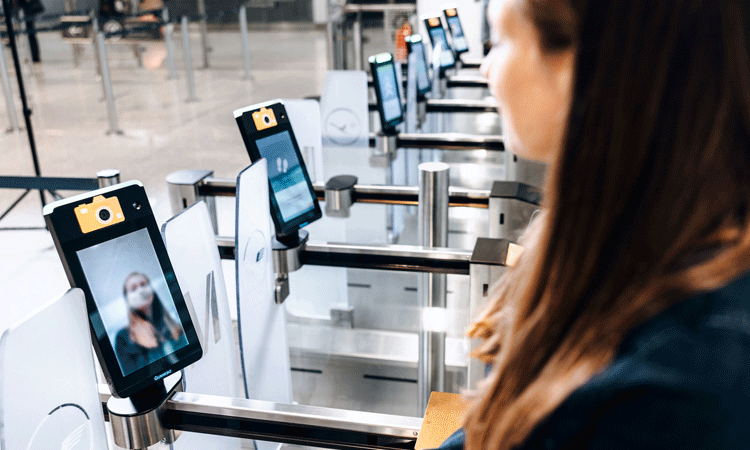Airport biometric security systems use technology to identify travelers. These systems enhance safety and efficiency at airports worldwide.
As air travel continues to grow, security remains a top concern. Traditional methods often slow down the boarding process and can be prone to human error. Biometric systems offer a solution. They use unique physical traits, like fingerprints or facial recognition, to verify identities quickly.
This technology not only speeds up the check-in and boarding processes but also reduces the risk of unauthorized access. Travelers enjoy a smoother experience while maintaining high security standards. Understanding how these systems work is essential for anyone who flies regularly. It reveals the future of airport security and the benefits it brings to our travel experiences.
The Rise Of Biometric Security
Biometric security is becoming more popular in airports. It uses unique human traits for identification. This method is faster and safer than traditional ways. Passengers feel more secure knowing their identity is protected. As technology advances, biometric systems improve. They offer convenience and efficiency for travelers worldwide.
From Traditional To Modern Security Measures
Traditional airport security relies on IDs and boarding passes. These methods can be slow and sometimes lead to errors. Passengers often face long lines and delays. Modern security measures are changing this. Biometric systems streamline the process.
Now, travelers can use fingerprints, facial recognition, or iris scans. These methods are quick and accurate. They help reduce wait times at checkpoints. Security staff can focus on more important tasks. This shift improves overall safety at airports.
Biometric Technology In A Nutshell
Biometric technology identifies people through unique features. It analyzes fingerprints, facial patterns, or voice. Each person has distinct traits. This makes biometric checks reliable.
Airports use advanced cameras and scanners. They capture and compare data instantly. Passengers simply walk through checkpoints. No need to show IDs repeatedly. This process saves time and enhances security.
As more airports adopt this technology, efficiency increases. Biometric security is changing how we travel. Passengers can enjoy a smoother experience at every step.
Credit: www.ibj.com
Components Of Airport Biometric Systems
Airport biometric systems use technology to enhance security and speed up processes. They rely on various components that help identify travelers accurately. Understanding these components is key to knowing how these systems work.
Facial Recognition Explained
Facial recognition is a popular biometric method. It analyzes facial features to identify individuals. The process includes several steps:
- Image Capture: Cameras take photos of faces.
- Feature Extraction: Unique facial features are identified.
- Comparison: The system compares features to a database.
- Verification: The system confirms the identity of the traveler.
This technology works quickly and efficiently. It can scan multiple faces at once. This helps reduce wait times at security checks.
Fingerprint And Iris Scanning Techniques
Fingerprint scanning and iris scanning are two other common methods. Both provide high accuracy in identification.
Here are the key points for each technique:
| Technique | Description | Advantages |
|---|---|---|
| Fingerprint Scanning | Scans the unique patterns of fingerprints. |
|
| Iris Scanning | Analyzes unique patterns in the iris of the eye. |
|
Both methods help ensure a safe airport experience. They provide quick and reliable identification for travelers.
Advantages Of Biometric Security At Airports
Biometric security systems at airports offer many benefits. They improve safety and make travel easier for passengers. These systems use unique traits like fingerprints and facial recognition. This technology helps identify travelers quickly and accurately.
Here are some key advantages of using biometric security at airports.
Enhanced Accuracy And Efficiency
Biometric systems provide high accuracy. They reduce human error in identifying passengers. Traditional methods often rely on ID checks. This can lead to mistakes or delays. Biometric data is unique to each person. This makes it difficult to forge or duplicate.
Efficiency improves as well. Security staff can focus on real threats. The technology scans passengers quickly. This speeds up the process. It ensures travelers get through security with less hassle.
Reducing Queues And Wait Times
Long lines can frustrate travelers. Biometric security helps cut down wait times. Automatic scans process passengers faster than manual checks. Many airports have introduced self-service kiosks. These allow quick and easy identity verification.
Shorter queues mean happier travelers. Less time spent waiting leads to a smoother experience. This also allows for better crowd management. Airports can handle more passengers efficiently.

Credit: www.aratek.co
Challenges Faced By Biometric Systems
Biometric systems at airports face various challenges. These issues can affect security and user experience. Understanding these challenges is crucial for improving the system.
Privacy Concerns And Data Protection
Privacy is a major concern for users of biometric systems. Many people worry about how their data is used and stored. Key issues include:
- Data Breaches: Sensitive information can be stolen.
- Informed Consent: Users may not fully understand data usage.
- Data Misuse: Information could be used for unintended purposes.
Protecting user data is essential. Regulations like the GDPR help. They set strict rules for data handling. Airports must comply to build trust.
Technological Hurdles And Reliability Issues
Biometric systems rely on technology. They face several hurdles, affecting their effectiveness:
- False Positives: Sometimes the system wrongly identifies users.
- False Negatives: Legitimate users may be denied access.
- Technical Failures: System outages can disrupt operations.
These issues can frustrate travelers. Airports must invest in reliable technology. Regular updates and maintenance are vital for performance.
Global Adoption And Case Studies
The use of biometric security in airports is growing worldwide. Many countries are adopting this technology. It helps improve safety and efficiency in air travel. Biometric systems use unique features, like fingerprints and facial recognition. This ensures that travelers are who they say they are. Let’s explore some success stories and different approaches in various countries.
Biometric Success Stories In Air Travel
In the United States, biometric systems have made a big difference. Several airports use facial recognition to speed up boarding. Passengers scan their faces at the gate. This process is quick and reduces waiting times. Travelers appreciate the smoother experience.
In Dubai, the biometric system is advanced. It uses facial recognition from check-in to boarding. Passengers walk through a seamless journey. They enjoy a hassle-free travel experience. This system has made Dubai International Airport one of the busiest in the world.
In Australia, airports are also embracing biometrics. They use fingerprint scanners for check-in and security. This approach has cut down on long lines. Travelers can move through the airport faster. The feedback from passengers has been positive.
Differing Approaches Across Countries
Countries have different ways of using biometric systems. In the UK, airports focus on privacy. They balance security with personal data protection. This ensures passengers feel safe while traveling.
In Singapore, the government supports biometric use. They see it as a way to enhance travel efficiency. The Changi Airport has integrated biometrics well. Travelers can enjoy a quick and smooth experience.
Some countries are still in the early stages. They are exploring how to implement these systems. This shows that the global approach to biometrics varies. Each country has its own challenges and solutions.
Integration With Existing Airport Security
Integrating the airport biometric security system with current security measures is essential. It strengthens safety without disrupting operations. This blend of technology and human checks enhances passenger experience and security efficiency.
Working Alongside Manual Checks
The biometric system complements manual checks. It does not replace them. Instead, both work together to ensure safety. Here are some ways they interact:
- Biometric scanners quickly verify identities.
- Manual checks focus on luggage and personal items.
- Staff can intervene if alerts occur.
This dual approach offers a layered security strategy. Passengers feel secure knowing that humans are still involved. The combination reduces wait times and enhances thoroughness.
Future-proofing Security Infrastructure
Upgrading to a biometric system prepares airports for future challenges. This system adapts to new threats. It also scales to handle increased passenger numbers. Consider these benefits:
| Benefits | Description |
|---|---|
| Enhanced Accuracy | Reduces errors in identity verification. |
| Speed | Faster processing times for travelers. |
| Cost-Effective | Lower long-term operational costs. |
| Scalability | Easily accommodates growing passenger volumes. |
Investing in this technology strengthens overall airport security. It prepares facilities for future needs. The integration fosters a more secure, efficient travel environment.
The Impact On Passenger Experience
The airport biometric security system changes how passengers travel. It offers a faster process for checking identities. This system uses facial recognition and fingerprint scans. Passengers experience less waiting time at security checks. The goal is to make flying easier and safer.
Balancing Security With Convenience
Passengers want safety but also speed. Biometric systems aim to provide both. They reduce long lines and speed up boarding. Quick identity checks help passengers feel less stressed.
Airports focus on a smooth experience. They know that long waits frustrate travelers. Biometric systems help keep lines moving. This balance is key to a positive travel experience.
The Role Of Passenger Feedback
Airports listen to passenger feedback. This input helps improve biometric systems. Travelers share their thoughts on speed and ease of use. Their opinions guide changes and updates.
Surveys and interviews gather valuable insights. Airports want to know what works and what doesn’t. This feedback helps create a better journey for all passengers.

Credit: www.internationalairportreview.com
The Road Ahead For Biometric Security
Biometric security systems are changing the way we travel. Airports are adopting these technologies to enhance safety. The future looks bright for biometric solutions. New trends and regulations will shape this field.
Emerging Trends In Biometric Technology
Several trends are shaping biometric technology today. Facial recognition is becoming more accurate and faster. Airports are using it to streamline passenger flow.
Fingerprint scanning is also evolving. New sensors can read fingerprints in different conditions. This will help in busy airport environments.
Voice recognition is gaining traction. Passengers can verify their identity through voice commands. This adds another layer of convenience and security.
Integration with mobile devices is key. Many travelers use their smartphones for boarding. Biometric checks through these devices will simplify the process.
Policy And Regulation Outlook
Policies for biometric security are still developing. Governments are focusing on data protection and privacy. Clear rules are needed to ensure public trust.
International cooperation is essential. Airports must align with global standards. This will make travel smoother and safer for everyone.
Transparency will play a crucial role. Passengers need to know how their data is used. This will help in building confidence in biometric systems.
Frequently Asked Questions
What Is An Airport Biometric Security System?
An airport biometric security system uses unique physical characteristics, like fingerprints or facial recognition, to identify passengers. This technology enhances security and streamlines the boarding process. It reduces the need for traditional identification methods, allowing for faster and more efficient passenger flow through security checkpoints.
How Does Biometric Security Enhance Airport Safety?
Biometric security enhances airport safety by accurately identifying individuals and reducing the risk of identity fraud. It allows for real-time monitoring of travelers, making it easier to detect potential threats. By automating the identification process, airports can respond faster to security incidents and enhance overall passenger safety.
What Are The Benefits Of Using Biometrics At Airports?
Using biometrics at airports offers numerous benefits, including improved efficiency and reduced wait times. Passengers enjoy a smoother travel experience as they can quickly pass through security. Additionally, biometric systems enhance security by accurately verifying identities, minimizing the chance of unauthorized access.
Are Biometric Systems Safe For Travelers?
Yes, biometric systems are generally safe for travelers. They use advanced encryption methods to protect personal data. Moreover, these systems are designed to comply with privacy regulations, ensuring that travelers’ information is handled securely. Overall, they provide a safe and efficient way to enhance airport security.
To Sum Up
Airport biometric security systems enhance safety and efficiency. They speed up the boarding process. Passengers enjoy a smoother travel experience. Airports reduce waiting times and manage crowds better. Biometric technology also helps identify threats quickly. This system builds trust between travelers and airport staff.
As more airports adopt this technology, we can expect improved security everywhere. Embracing biometrics is a step toward safer skies and happier travelers. Understanding these systems prepares us for the future of air travel. Everyone benefits from a safer and more efficient airport experience.







